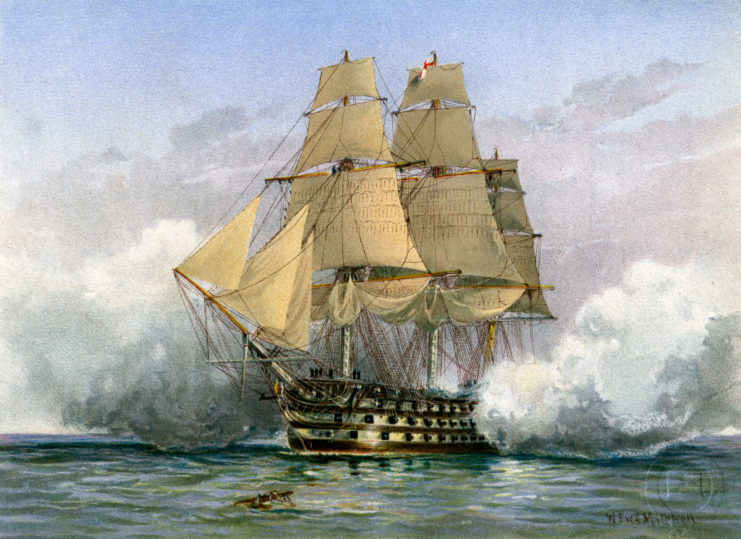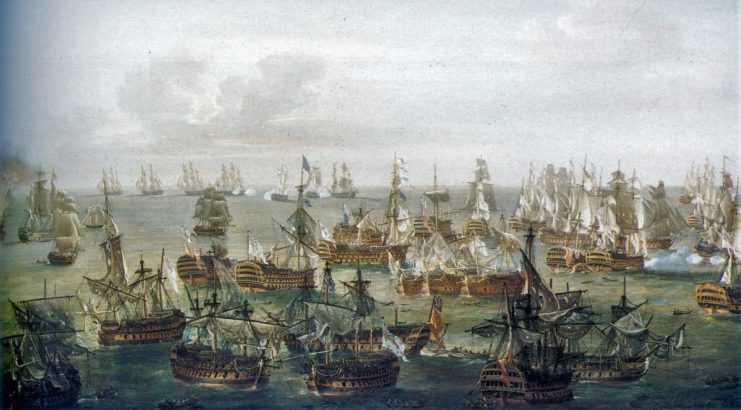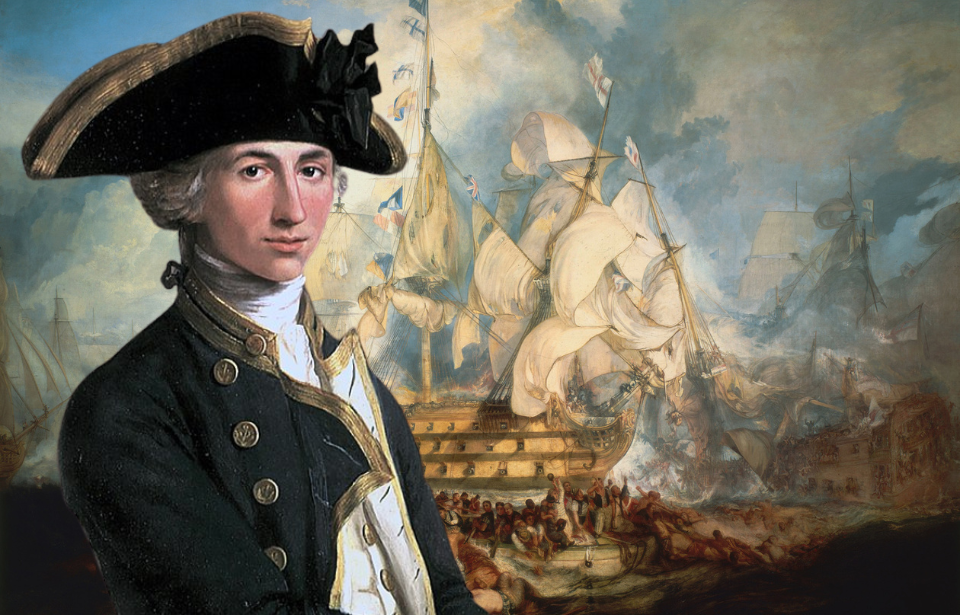The Battle of Trafalgar is among the most famous naval battles in history. Facing a joint force made up of French and Spanish vessels, the British, led by Vice Adm. Horatio Nelson, had a tense fight ahead of them. While they would ultimately come out victorious, their success came at a price: the loss of their fierce leader.
Vice Adm. Horatio Nelson

Horatio Nelson was the pride of the fleet, his captains and men, and the British public. The third surviving son of a middle-class family, he’d risen to almost the highest rank in the Royal Navy. His career was admirable and his rise through the ranks steady, like his character. Nelson cared deeply about the men and vessels under his command; his country, duty, monarch and religion were the pillars of his existence.
On October 21, 1805, he stood on the quarterdeck of his great flagship, the HMS Victory. His staff stood around him, the chief among them being the vessel’s captain, Thomas Hardy. To Nelson’s left stood his purser and prize agent, John Scott. It was his job to record the progress of the Battle of Trafalgar as it went on, and, to this end, had set up on deck a chair and table, complete with ink pots, paper and pens – a most incongruous sight in the midst of the preparations for such an engagement.
Here also were the ship’s surgeon, William Beatty, and John Pasco, the young and enthusiastic signals officer. These officers were attended by clerks and servants, and, all around them, the gunners and soldiers were poised at their posts, ready for the coming fight.
Preparing for the Battle of Trafalgar

This was the moment when the Battle of Trafalgar was, at last, about to begin. South of Cadiz and west of Gibraltar, in a long, heavy swell, the great fleet was assembled to face the combined might of the allied French and Spanish navies.
The sun was high, the wind light and breezy. Nelson’s fleet was outnumbered and outgunned, and the importance of the battle couldn’t be overstated. If he was victorious, the Franco-Spanish navies would never again challenge Britain at sea. If he were defeated, the country would be left open to invasion by French Emperor Napoleon Bonaparte.
Nelson’s fleet was arranged in two lines, laid at right angles to the line of the Franco-Spanish force. They were on course to punch into the enemy line at two points, breaking up the fleet’s cohesion and ability to signal, and forcing them into a ship-by-ship fight. Victory was at the front of the forward line and driving straight toward the French flagship Bucentaure.
On the quarterdeck, Nelson stood in his admiral’s uniform. This concerned Hardy and Beatty, both of whom cared deeply about their brave leader’s safety. They were afraid his presence on the quarterdeck, openly displaying his rank, would mark him out to the enemy.
Beatty was inclined to plead with Nelson to at least cover the silver stars on his breast with a cloth or a handkerchief, but Scott warned him off. “Take care, doctor,” he said to Beatty, “I would not be the man to mention such a matter to him.” Nelson’s distaste in the matter of hiding himself from danger was well-known. Hardy had tried to convince him to decamp to another ship before the melee began, but was met with exasperated refusal.
The Battle of Trafalgar commences

It was15 minutes before noon when Nelson gave the order to Pasco to run up the famous signal, which still resonates down the ages to this day: “England expects that every man will do his duty.”
Just after noon, the opening shots were fired as the HMS Royal Sovereign (1776) came under fire. The vessel was in the charge of Nelson’s partner-in-command, Vice Adm. Cuthbert Collingwood, and the lead ship of the second line, which now bore down upon the enemy.
Shortly after this, Victory herself came under fire. Placed as she was with her bows toward the enemy’s sides, four of the French ships were able to bring their guns to bear down on her, but she could not yet return fire. At first, the barrage was ineffective, the shots splashing into the water or skimming off Victory‘s great curved bow, but as Nelson’s line sped on, the vessel began to take damage.
Wood splintered, shots punched through sailcloth, and smashed onto the decks and into ranks of crewmen. To Nelson’s left, Scott, was hit in the belly by a cannonball. He collapsed, dead and broken, and his blood pooled. As was customary at sea, his corpse was quickly lifted up and heaved overboard.
The HMS Victory continues to take heavy enemy fire

The thunder of the guns grew louder and louder as Victory approached the enemy, but still she couldn’t return fire. Through his spy glass, Nelson could observe Collingwood’s line, the first three ships of which now were fiercely engaged in battle. He could see the cannon flashes and, a few seconds later, the muffled boom of them reached his ears. White smoke was beginning to surround the engagement, obscuring his view, and he returned his attention to his own quarterdeck.
Hardy’s clerk had taken over for Scott and moved to the table, where he began to try to write what he was observing. As soon as he picked up his pen, another volley of shots pounded Victory. One cannonball took the clerk’s life and smashed the table to pieces.
Nelson remained calm. He stood straight and tall, observing as well as he could. The roar of the enemy cannons were deafening, and the air was filled with smoke, shrapnel and flying debris. He turned to Hardy, who stood tense and ready at his side. “This is too warm work, Hardy, to go on for long,” he said. Hardy nodded grimly.
Victory took heavy fire for a full 45 minutes before she was able to bring her 100-gun arsenal to bear. When she did, the results were devastating. On one side was Bucentaure. One the other, the great 74-gunner Redoubtable (1795). Bucentaure took the full brunt of a broadside at close quarters. The great ship rocked and her guns were silenced.
Victory then focused her fire on Redoutable, keeping up continuous fire as the two great ships drew alongside each other. As they rocked back and forth with the impact and retort of the cannons, their masts became entangled. Onboard Redoutable, infantry prepared for a boarding action. Victory‘s guns ceased firing as her crew was ordered up to fight the boarders. As the ships grew closer, the French infantry threw grenades at Victory, driving the crew back below deck.
Vice Adm. Horatio Nelson dies by enemy action

It was in the midst of this chaos that a man in the rigging of Redoutable spied the four silver stars on the figure far below him. He was a crack shot, placed to best advantage high above the action and armed with a long smooth bore rifle. He didn’t waste time in taking his shot. Below him, the blue coated figure dropped to its knees.
It took a moment for Hardy to realize what had happened. When he looked and saw Nelson on one knee, he rushed to his side. The vice admiral looked up at him, and his mouth twisted into a wry smile. “They finally succeeded,” he gasped. “I am dead.”
The crew carried Nelson below and made him as comfortable as they could. His breathing came in short gasps, his face deathly pale, and a clammy sweat clung to his brow. Hardy returned to the quarterdeck to continue command, only to find the French boarding action had been curtailed by a brutal fire from the next British ship in line.
Shortly afterward, Redoutable surrendered, having lost most of her crew and taken heavy damage. Hardy hurried between the quarterdeck and the surgeon’s station below, delivering updates to Nelson about the progress of the battle.
Nelson’s strategy was incredibly effective. Robbed of their ability to communicate or maneuver effectively, the Franco-Spanish fleet surrendered to the British. It took another five hours to complete, but, by the time the remainder of the French ships had fled, Nelson was dead. He had held on long enough to be sure of the victory.
“Thank God I have done my duty,” he whispered.
Horatio Nelson has gone down in history as on one of the greatest naval commanders in British history. Following the Battle of Trafalgar, Napoleon abandoned plans for a land invasion across the English Channel, and never again challenged the British at sea.
Want War History Online‘s content sent directly to your inbox? Sign up for our newsletter here!
The HMS Victory is one of very few ships from that era still in existence. She was restored in the early 20th century, and is docked at Portsmouth, where she’s become a popular visitor attraction and an enduring reminder of Nelson’s bravery and leadership.
